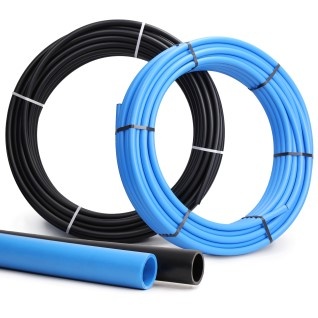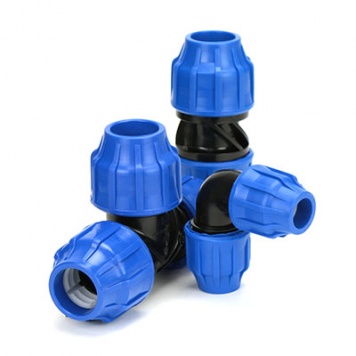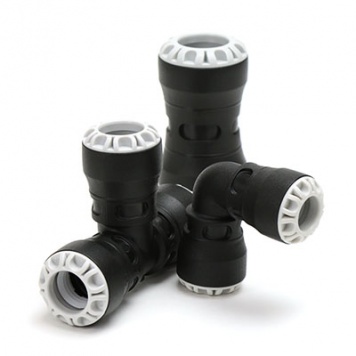
MDPE Pipe: The Ultimate Guide
Everything you'll ever need to know about MDPE pipe
Published: 14th June 2023 - Updated: 26th September 2025
What does MDPE stand for?
Medium-Density Polyethylene.
What is MDPE pipe made from?
MDPE pipe is made from Polyethylene which is the most commonly produced plastic worldwide. The particular type used for MDPE pipe is defined by a density range of 0.926–0.940 g/cm3 (medium-density). This offers fantastic flexibility (as it’s available in coils) as well as incredible durability against stress cracking.
Is MDPE known by any other names?
You may hear it referred to by its previous name Alkathene, blue water pipe or shortened to simply PE.
What is MDPE pipe used for?
The most common use of MDPE is for potable water (drinking water). It is specifically designed for this purpose, and its smooth bore prevents bacterial buildup while providing low friction and high flow rates. MDPE is also widely used in irrigation and agriculture.
It also has good resistance to a range of chemicals but ABS, PVC or specialist plastics are more commonly used in these applications.
What is the difference between blue and black MDPE pipe?
Apart from the obvious colour difference, black MDPE is UV stabilised meaning it can be used above ground. Blue MDPE is not UV stabilised meaning it is only suitable to be used below ground. Blue MDPE pipe is approved for use with drinking water and allows for easy identification of potable water lines underground.
How is MDPE pipe measured?
Measurements of standard MDPE are always taken from the outside diameter of the pipe. Check out our handy table below for MDPE pipe measurements & ratings. MDPE is only sold in metric sizes here in the UK.
| MDPE Pipe Dimensions, Metric, BS EN 15494:2003 |
|||||
| Pipe Size (mm) | Average Bore Inside Diameter (mm) | Average Wall Thickness (mm) | Approximate Weight per Metre (kg) | PE Rating | SDR Rating |
| 20 | 15.2 | 2.4 | 0.13 | 80 | 11 |
| 25 | 20.1 | 2.5 | 0.17 | 80 | 11 |
| 32 | 25.8 | 3.1 | 0.28 | 80 | 11 |
| 50 | 40.4 | 4.8 | 0.67 | 80 | 11 |
| 63 | 50.9 | 6.1 | 1.05 | 80 | 11 |
| 90 | 78.7 | 5.7 | 1.39 | 100 | 17 |
| 110 | 96.3 | 6.9 | 2.06 | 100 | 17 |
| 125 | 109.5 | 7.8 | 2.66 | 100 | 17 |
| 160 | 140.3 | 9.8 | 4.38 | 100 | 17 |
| 180 | 158.0 | 11.0 | 5.49 | 100 | 17 |
Does MDPE pipe freeze?
While plastic pipe is more resistant to freezing than metal pipe, precautions should be taken to insulate the pipe when using above ground (generally black pipe). Blue MDPE pipe buried to a minimum depth of 900mm will provide excellent resistance to freezing.
How long does MDPE pipe last?
While it is difficult to give an exact answer due to many varying factors they have a minimum service life of 50 years. According to a recent study, they could potentially last over 100 years!
What fittings can be used on MDPE pipe?
The most commonly used method for small bore MDPE is with compression fittings as they are the most cost-effective, easy to install and require no specialist equipment. Other methods include innovative push-fit fittings and more high tech electrofusion. For MDPE pipe with a diameter of 90mm and above, electrofusion fittings are the most commonly used.
When installing compression fittings we recommend the use of a strap wrench to ensure fittings are sufficiently tightened. Pipe liners are also required to maintain rigidity in the pipe.
How do I cut MDPE pipe?
For a clean and effortless cut we recommend the use of a ratchet cutter. Simply pull the button on the top of the ratchet cutter back to retract the blade, place the pipe against the grooved bottom of the cutter then keep squeezing the handle till the cut is complete. A perfectly clean cut!
For a full rundown on this method and more, check out our video below!
How do I join MDPE pipe together?
The most popular method for joining MDPE pipe (as mentioned above) is by the use of compression fittings. These are incredibly easy to install, the most cost-effective and do not require the use of any specialist equipment.
Compression Fittings
- Insert a pipe liner into the pipe
- Loosen the retaining nut without removing it to ensure easy insertion
- Gently insert the pipe into the fitting making sure to push past the o-ring seal
- Tighten the nut by hand then finish with a strap wrench
Push Fit Fittings
- Insert a pipe liner into the pipe
- Place the pipe parallel to the fitting, then using the depth indicator under the fitting, mark the pipe appropriately
- Press the pipe into the fitting until your marking reaches the nut to ensure full insertion
The video below will show you everything you need to know about joining pipes with compression & push fit fittings. Please note: Solvent cement is NOT required for joining MDPE pipe together.
The other method is by Electrofusion. Electrofusion is a method of joining plastic pipes by using fittings with built-in electric heating elements, which are used to weld the joint together. Electrofusion fittings can be used for both water and gas.
For a detailed guide, check out our video below.
How do I connect MDPE pipe to Copper?
Here are two simple ways to connect MDPE to Copper:
- Push Fit Fittings - These are available in the form of couplings, threaded adaptors and stop taps. As the name suggests, simply push the pipe into the fitting for a secure connection.
- Transition Fittings - These fittings are more like a traditional compression fitting. Simply attach the MDPE & Copper to their correct ends, then screw to tighten. We recommend the use of a strap wrench.
Please note: Pipe liners are required to maintain rigidity in the pipe.
Can I bury MDPE pipe?
Yes, and this is generally the preferred method of installation, especially for potable water using blue MDPE pipe. Blue MDPE does not have UV resistance (unlike black MDPE) so it is not recommended to be used above ground.
When burying MDPE pipe the standard minimum depth of cover should be 900mm from ground level to the crown of the pipe. The minimum trench width should be the diameter of the pipe plus 250mm to allow for sufficient compaction of side fill.
Still have questions? Get in touch via the contact us page.




